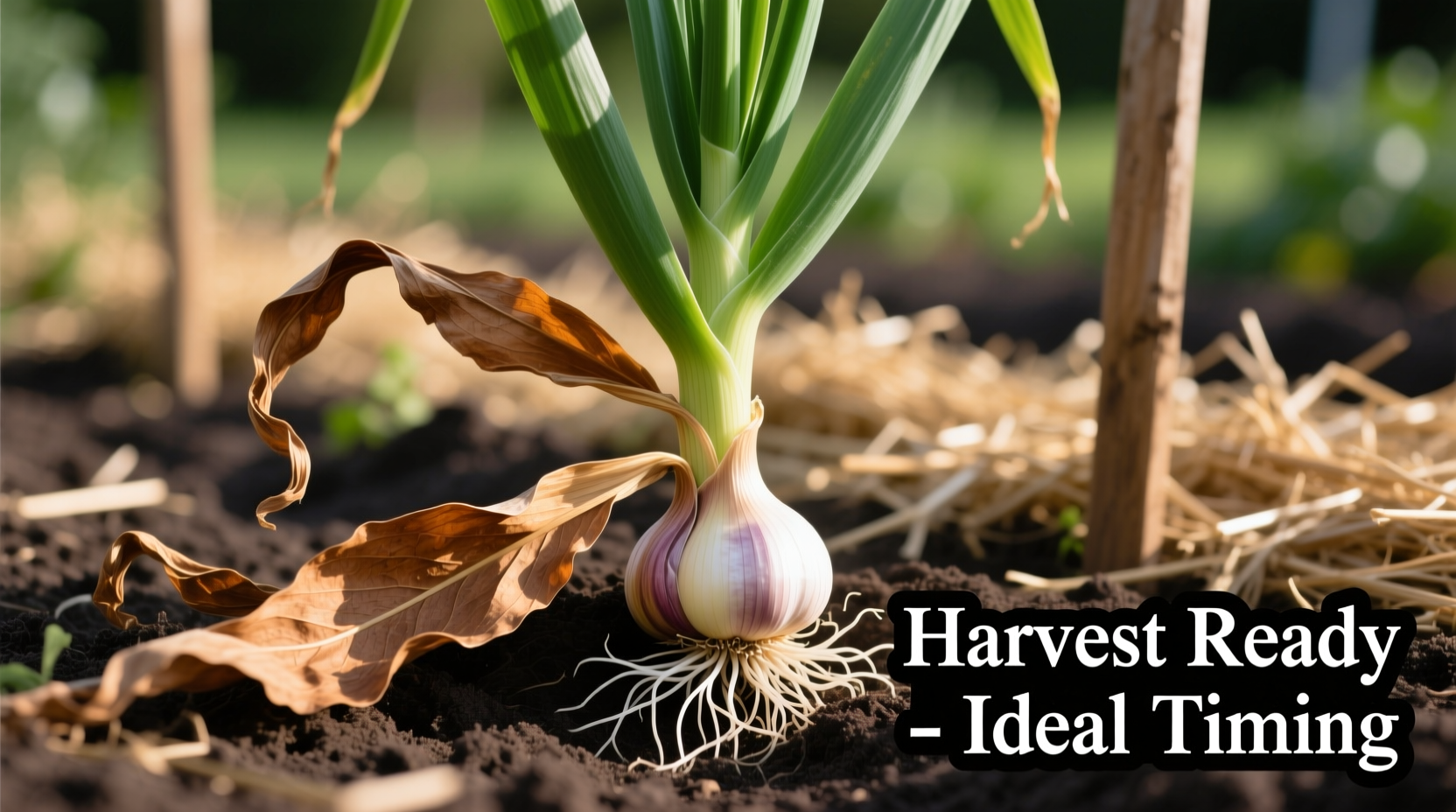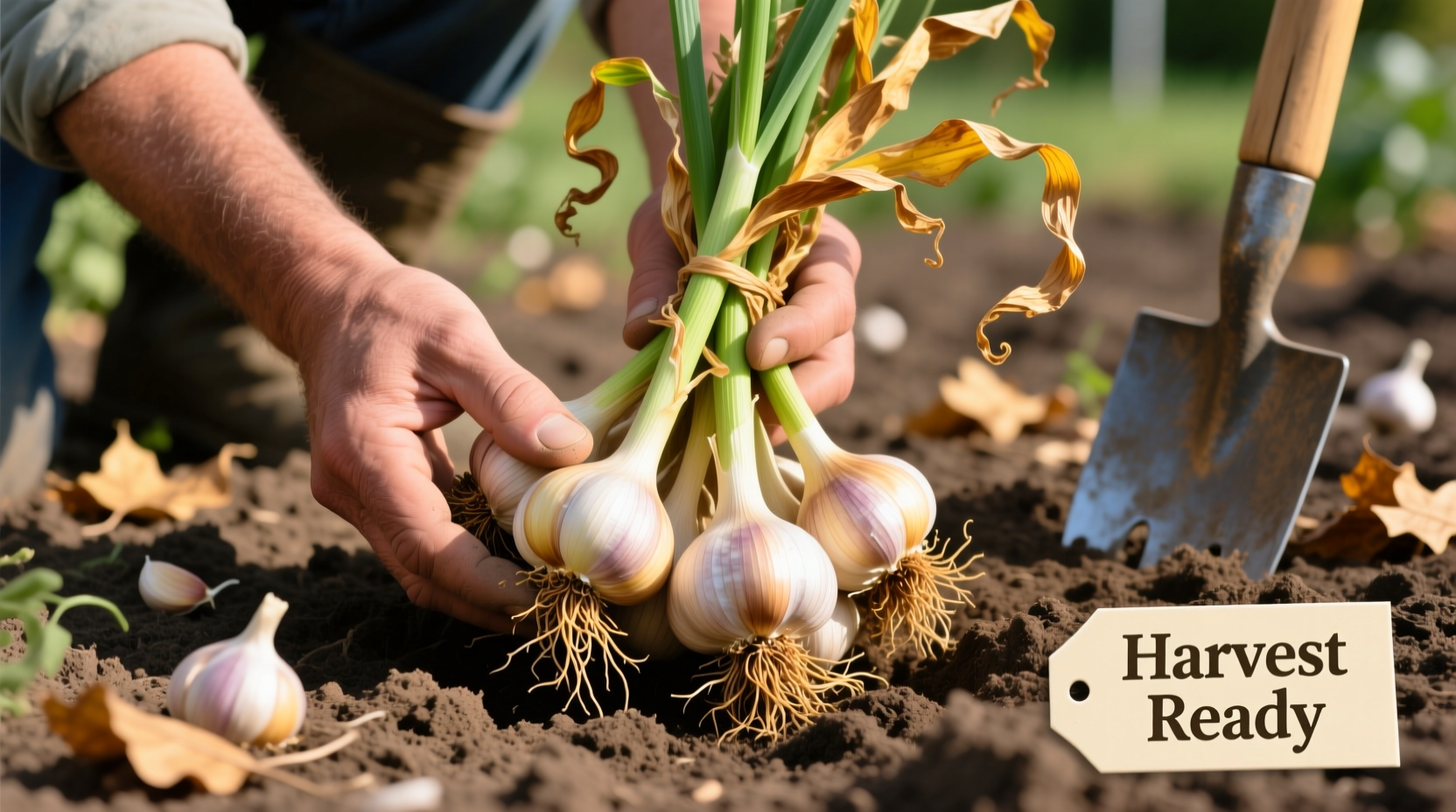Harvesting garlic at the perfect moment makes the difference between plump, well-formed bulbs with tight wrappers and disappointing results. Too early, and your cloves will be undersized; too late, and the bulbs may split open, reducing storage life. Getting the timing right ensures maximum flavor, size, and shelf stability for your homegrown garlic.
What Your Garlic Leaves Are Telling You
Garlic communicates its readiness through visual cues, primarily in the leaves. As harvest approaches, you'll notice a gradual color change starting from the bottom of the plant. The transformation follows a predictable pattern:
| Leaf Condition | Harvest Readiness | Expected Results |
|---|---|---|
| Lower 1/3 brown, upper 2/3 green | Optimal harvest time | Fully developed cloves with tight wrappers |
| Half brown, half green | Harvest immediately | Good size but wrappers may loosen |
| Mostly brown | Harvest now or lose quality | Bulbs may split, reducing storage life |
| Completely green | Too early | Small cloves, poor development |
This visual indicator works because as the plant matures, it redirects energy from the leaves to the bulb. When approximately 40% of the leaves have turned brown (starting from the bottom), the bulb has reached maximum size but the wrappers remain intact. Waiting until more than 50% of leaves die back risks the protective layers deteriorating, which compromises storage potential.

Understanding Garlic's Growth Timeline
Garlic follows a predictable growth cycle that varies slightly by variety and climate. Understanding this progression helps you anticipate harvest time:
| Growth Stage | Timeframe | Key Characteristics |
|---|---|---|
| Planting | Fall (October-November) | Cloves planted 2-4 inches deep, 6 inches apart |
| Root Development | Winter | Roots establish while top growth minimal |
| Leaf Growth | Early spring | Green shoots emerge, rapid vertical growth |
| Bulb Formation | Late spring | Energy shifts to bulb development |
| Maturation | Early to mid-summer | Leaves begin dying back from bottom up |
| Harvest Ready | When 30-50% leaves browned | Optimal bulb size with intact wrappers |
According to research from the Oregon State University Extension Service, hardneck varieties typically mature 1-2 weeks before softneck types. In northern climates, hardnecks are usually ready between late June and mid-July, while softnecks follow 1-3 weeks later. Southern growers may see harvest windows shifting to May for hardnecks and June for softnecks.
The Test Dig Method: Confirming Harvest Readiness
While visual leaf indicators are reliable, performing a test dig provides definitive confirmation. About 3-4 weeks before your expected harvest date:
- Select 2-3 representative plants from different areas of your patch
- Carefully loosen the soil around the bulb with a garden fork
- Gently lift the bulb from the ground
- Examine the bulb's condition
Look for these characteristics in your test bulbs:
- Wrapper integrity - The papery layers should be intact and relatively tight
- Clove definition - Individual cloves should be clearly formed and plump
- Bulb size - Should match the expected size for your variety
- Root condition - Roots should be dry and brittle rather than moist and white
If your test bulbs show well-developed cloves with intact wrappers, you're approaching harvest time. If cloves are still small or the wrapper is thin and translucent, wait another week before testing again.
Regional Considerations for Garlic Harvesting
Garlic harvest timing varies significantly by climate zone. The USDA Agricultural Research Service notes that temperature fluctuations affect maturation rates:
- Cooler northern climates - Longer growing season (8-9 months), harvest typically late June to mid-July
- Moderate climates - Standard 7-8 month season, harvest mid-June to early August
- Warmer southern climates - Shorter season (6-7 months), harvest May to early July
- Container gardening - Often matures 1-2 weeks earlier than in-ground plants
Pay attention to local weather patterns in your final weeks. An unusually hot, dry spell can accelerate maturation, while cool, wet conditions may delay it. In regions with early summer heat waves, you might need to harvest slightly earlier than leaf indicators suggest to prevent bulb damage.
What Happens When You Harvest at the Wrong Time
Timing mistakes affect both immediate quality and long-term storage. Understanding these consequences helps reinforce why precision matters:
Harvesting Too Early
When you pull garlic before it's fully mature:
- Cloves remain small and underdeveloped
- Bulb wrappers are thin and delicate
- Flavor profile hasn't fully developed
- Storage life significantly reduced (may last only 1-2 months)
Harvesting Too Late
Waiting too long creates different problems:
- Bulb wrappers deteriorate and split open
- Cloves may begin to separate and lose their tight formation
- Increased risk of soil-borne diseases entering the bulb
- Flavor becomes sharper and less complex
- Storage life dramatically shortened (may sprout in storage)
The University of Minnesota Extension reports that garlic harvested at peak maturity typically stores 6-8 months under proper conditions, while improperly timed harvests may last only 1-3 months.
Harvesting Techniques for Maximum Quality
Once you've determined your garlic is ready, proper harvesting technique preserves quality:
- Choose the right day - Harvest during dry weather after several rain-free days
- Time your harvest - Early morning is ideal when temperatures are cooler
- Use proper tools - A garden fork works better than a shovel to avoid piercing bulbs
- Handle gently - Avoid bruising bulbs which creates entry points for rot
- Leave stems intact - Don't cut stems until after curing is complete
After lifting, gently brush off excess soil but avoid washing the bulbs. Keep them out of direct sunlight during the initial curing process, which begins immediately after harvest.
Special Considerations for Different Garlic Types
Understanding your specific garlic variety helps refine your harvest timing:
Hardneck Garlic
These varieties (including Rocambole, Purple Stripe, and Porcelain types) produce a central flower stalk (scape) that should be removed 4-6 weeks before harvest. Hardnecks typically mature earlier than softnecks and show more dramatic leaf dieback. They're ready when 40% of leaves have turned brown, usually in late June to mid-July in most climates.
Softneck Garlic
Common supermarket varieties (like Silverskin and Artichoke types) lack a central scape and mature later than hardnecks. They often require waiting until 50% of leaves have died back. Softnecks can be trickier to judge because their leaves stay greener longer while the bulb matures. In warmer climates, they may not show significant dieback until late July or early August.
According to the Oregon State University Extension, elephant garlic (actually a type of leek) follows different timing and should be harvested when about 60% of leaves have died back, typically later than true garlic varieties.
Your Next Steps After Harvest
Proper harvesting is just the beginning. To ensure your garlic stores well:
- Cure bulbs in a shaded, well-ventilated area for 2-3 weeks
- Trim roots and stems after curing is complete
- Store in mesh bags or braids in a cool, dry place
- Check stored garlic monthly for any signs of spoilage
Well-harvested and properly cured garlic should develop its full, complex flavor after 2-4 weeks of storage. Don't be tempted to use your fresh harvest immediately—waiting allows the flavors to mellow and intensify.











 浙公网安备
33010002000092号
浙公网安备
33010002000092号 浙B2-20120091-4
浙B2-20120091-4